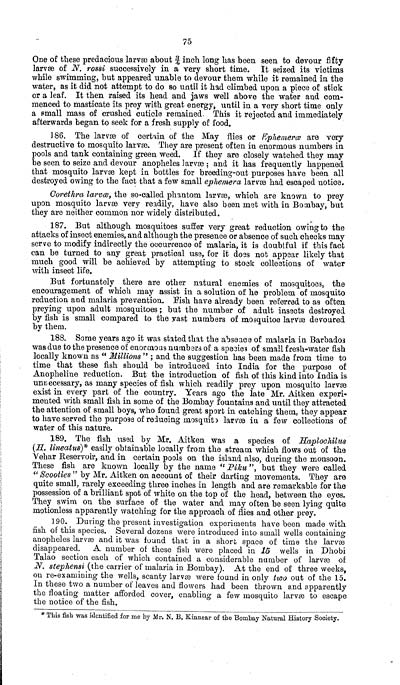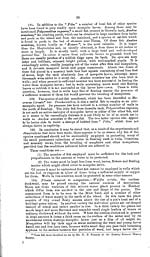Medicine - Disease > Report of an investigation into the causes of malaria in Bombay and the measures necessary for its control
(113) Page 75
Download files
Individual page:
Thumbnail gallery: Grid view | List view

75
One of these predacious larv about 3/4 inch long has been seen to devour fifty
larv of N. rossi successively in a very short time. It seized its victims
while swimming, but appeared unable to devour them while it remained in the
water, as it did not attempt to do so until it had climbed upon a piece of stick
or a leaf. It then raised its head and jaws well above the water and com-
menced to masticate its prey with great energy, until in a very short time only
a small mass of crushed cuticle remained. This it rejected and immediately
afterwards began to seek for a fresh supply of food.
186. The larv of certain of the May flies or Ephemer are very
destructive to mosquito larv. They are present often in enormous numbers in
pools and tank containing green weed. If they are closely watched they may
be seen to seize and devour anopheles larv; and it has frequently happened
that mosquito larv kept in bottles for breeding-out purposes have been all
destroyed owing to the fact that a few small ephemera larv had escaped notice.
Corethra larv, the so-called phantom larv, which are known to prey
upon mosquito larv very readily, have also been met with in Bombay, but
they are neither common nor widely distributed.
187. But although mosquitoes suffer very great reduction owing to the
attacks of insect enemies, and although the presence or absence of such checks may
serve to modify indirectly the occurrence of malaria, it is doubtful if this fact
can be turned to any great practical use, for it does not appear likely that
much good will be achieved by attempting to stock collections of water
with insect life.
But fortunately there are other natural enemies of mosquitoes, the
encouragement of which may assist in a solution of he problem of mosquito
reduction and malaria prevention. Fish have already been referred to as often
preying upon adult mosquitoes; but the number of adult insscts destroyed
by fish is small compared to the vast numbers of mosquitoe larv devoured
by them.
188. Some years ago it was stated that the absence of malaria in Barbados
was due to the presence of enormous numbers of a species of small fresh-water fish
locally known as "Millions"; and the suggestion has been made from time to
time that these fish should be introduced into India for the purpose of
Anopheline reduction. But the introduction of fish of this kind into India is
unnecessary, as many species of fish which readily prey upon mosquito larv
exist in every part of the country. Years ago the late Mr. Aitken experi-
mented with small fish in some of the Bombay fountains and until they attracted
the attention of small boys, who found great sport in catching them, they appear
to have served the purpose of reducing mosquito larv in a few collections of
water of this nature.
189. The fish used by Mr. Aitken was a species of Haplochilus
(H. lineatus)* easily obtainable locally from the stream which flows out of the
Vehar Reservoir, and in certain pools on the island also, during the monsoon.
These fish are known locally by the name "Piku", but they were called
"Scooties" by Mr. Aitken on account of their darting movements. They are
quite small, rarely exceeding three inches in length and are remarkable for the
possession of a brilliant spot of white on the top of the head, between the eyes.
They swim on the surface of the water and may often be seen lying quite
motionless apparently watching for the approach of flies and other prey.
190. During the present investigation experiments have been made with
fish of this species. Several dozens were introduced into small wells containing
anopheles larv and it was found that in a short space of time the larv
disappeared. A number of these fish were placed in 15 wells in Dhobi
Talao section each of which contained a considerable number of larv of
N. stephensi (the carrier of malaria in Bombay). At the end of three weeks,
on re-examining the wells, scanty larv were found in only two out of the 15.
In these two a number of leaves and flowers had been thrown and apparently
the floating matter afforded cover, enabling a few mosquito larv to escape
the notice of the fish.
* This fish was identified for me by Mr. N. B. Kinnear of the Bombay Natural History Society.
One of these predacious larv about 3/4 inch long has been seen to devour fifty
larv of N. rossi successively in a very short time. It seized its victims
while swimming, but appeared unable to devour them while it remained in the
water, as it did not attempt to do so until it had climbed upon a piece of stick
or a leaf. It then raised its head and jaws well above the water and com-
menced to masticate its prey with great energy, until in a very short time only
a small mass of crushed cuticle remained. This it rejected and immediately
afterwards began to seek for a fresh supply of food.
186. The larv of certain of the May flies or Ephemer are very
destructive to mosquito larv. They are present often in enormous numbers in
pools and tank containing green weed. If they are closely watched they may
be seen to seize and devour anopheles larv; and it has frequently happened
that mosquito larv kept in bottles for breeding-out purposes have been all
destroyed owing to the fact that a few small ephemera larv had escaped notice.
Corethra larv, the so-called phantom larv, which are known to prey
upon mosquito larv very readily, have also been met with in Bombay, but
they are neither common nor widely distributed.
187. But although mosquitoes suffer very great reduction owing to the
attacks of insect enemies, and although the presence or absence of such checks may
serve to modify indirectly the occurrence of malaria, it is doubtful if this fact
can be turned to any great practical use, for it does not appear likely that
much good will be achieved by attempting to stock collections of water
with insect life.
But fortunately there are other natural enemies of mosquitoes, the
encouragement of which may assist in a solution of he problem of mosquito
reduction and malaria prevention. Fish have already been referred to as often
preying upon adult mosquitoes; but the number of adult insscts destroyed
by fish is small compared to the vast numbers of mosquitoe larv devoured
by them.
188. Some years ago it was stated that the absence of malaria in Barbados
was due to the presence of enormous numbers of a species of small fresh-water fish
locally known as "Millions"; and the suggestion has been made from time to
time that these fish should be introduced into India for the purpose of
Anopheline reduction. But the introduction of fish of this kind into India is
unnecessary, as many species of fish which readily prey upon mosquito larv
exist in every part of the country. Years ago the late Mr. Aitken experi-
mented with small fish in some of the Bombay fountains and until they attracted
the attention of small boys, who found great sport in catching them, they appear
to have served the purpose of reducing mosquito larv in a few collections of
water of this nature.
189. The fish used by Mr. Aitken was a species of Haplochilus
(H. lineatus)* easily obtainable locally from the stream which flows out of the
Vehar Reservoir, and in certain pools on the island also, during the monsoon.
These fish are known locally by the name "Piku", but they were called
"Scooties" by Mr. Aitken on account of their darting movements. They are
quite small, rarely exceeding three inches in length and are remarkable for the
possession of a brilliant spot of white on the top of the head, between the eyes.
They swim on the surface of the water and may often be seen lying quite
motionless apparently watching for the approach of flies and other prey.
190. During the present investigation experiments have been made with
fish of this species. Several dozens were introduced into small wells containing
anopheles larv and it was found that in a short space of time the larv
disappeared. A number of these fish were placed in 15 wells in Dhobi
Talao section each of which contained a considerable number of larv of
N. stephensi (the carrier of malaria in Bombay). At the end of three weeks,
on re-examining the wells, scanty larv were found in only two out of the 15.
In these two a number of leaves and flowers had been thrown and apparently
the floating matter afforded cover, enabling a few mosquito larv to escape
the notice of the fish.
* This fish was identified for me by Mr. N. B. Kinnear of the Bombay Natural History Society.
Set display mode to: Large image | Zoom image | Transcription
Images and transcriptions on this page, including medium image downloads, may be used under the Creative Commons Attribution 4.0 International Licence unless otherwise stated. ![]()
| India Papers > Medicine - Disease > Report of an investigation into the causes of malaria in Bombay and the measures necessary for its control > (113) Page 75 |
|---|
| Permanent URL | https://digital.nls.uk/74573222 |
|---|




